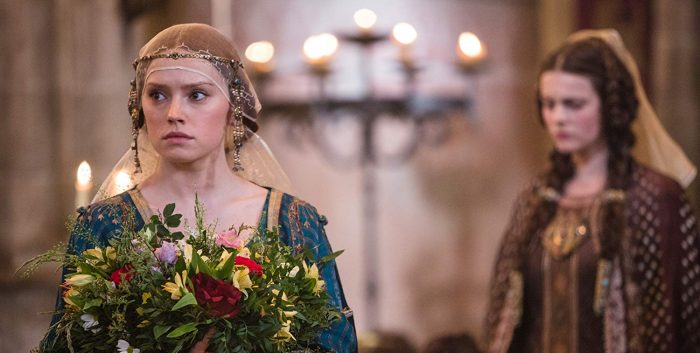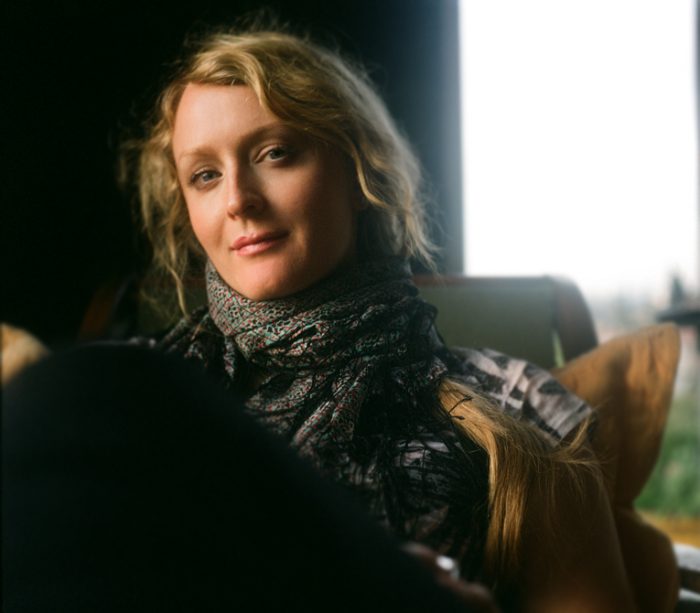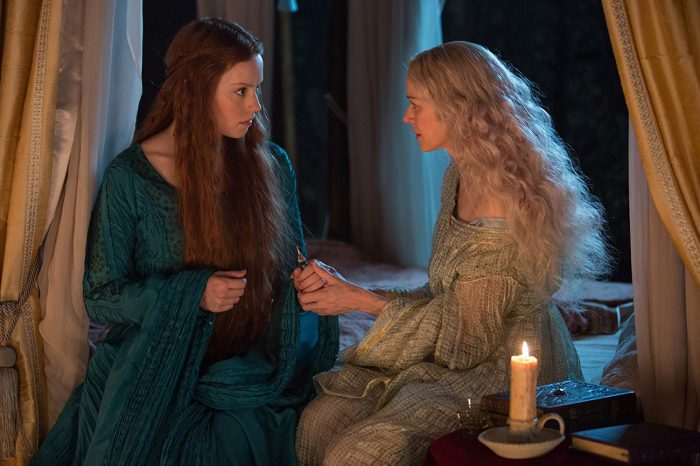
Ophelia is one of the most maligned characters in literary history. It’s not entirely her fault — the tragic heroine of Hamlet suffers from being not much of a heroine, but rather a cipher for the purity and virtue of women and all that will befall them when that innocence is corrupted by the world. She’s best known for her descent into madness, culminating in a suicide whose tragic beauty has been enshrined in many an oil painting. But Australian filmmaker Claire McCarthy’s (The Turning, The Waiting City) upcoming Shakespeare retelling Ophelia asks, what if Ophelia was more? More active, more assured, more than just a laundry list of perfect virtues.
Ophelia is a revisionist retelling of Hamlet that imagines the classic Shakespeare tragedy from the point of view of the doomed heroine. But McCarthy wanted to do more than simply depict a straightforward adaptation of Hamlet based only on Ophelia’s brief interactions with the story.
“This was an opportunity to capture her point of view and her particular insights about the dynamics around her without having to make her feel passive or a victim like she was in the original play,” McCarthy said in an interview with /Film. “So how do you have that feel like she has currency and interest, how can we remain with her even if she’s not the one compelling the narrative?”
Part of that is accomplished simply with the casting of Star Wars: The Last Jedi’s Daisy Ridley, who McCarthy praised for having a “contemporary vulnerability but also a strength to her.” While Ridley wouldn’t be getting into any physical scraps with anyone, she also wouldn’t be the helpless damsel whose greatest legacy is in how beautifully she drowns. McCarthy talks how much of Hamlet’s classic story is changed in Ophelia, Ridley as the Romantic icon, and how the film inverts the male gaze through the characters played by Ridley and Naomi Watts in an interview with /Film.

What drew you to this story of an Ophelia-focused retelling of Hamlet?
She’s such a tragic icon. I had the opportunity to study the play — I did a thesis on the play when I was in high school — so I’ve always loved Hamlet and been intrigued by Ophelia. So reading [Semi Chellas’] screenplay, it just struck me as a really interesting opportunity and timely opportunity to give her a different opportunity to speak on her own terms.
’It struck me that, with the period setting and its riff on arguably one of Shakespeare’s most beloved and sublime masterworks, so many things could go wrong. We didn’t try to go too lofty or high-brow, but the work is trying to set up the best circumstances for a younger audience to feel for these characters, in particular Ophelia and relate to her struggle and be emotionally moved. And it felt like a good opportunity to do that and to press into a lot of things that are within a play but to do it in such a way that a younger audience don’t feel like they’re having to take their vitamins. Those things are really interesting and challenging to think about: Does the language need to be updated, and how do we make the interactions feel contemporary, what kind of casting approach would we have, how do we create that world so it feels really balanced and tonally specific to that world of Shakespeare, but it doesn’t feel like it’s drab or boring? We have texture, and intrigue, and how do we create that castle and these particular character dynamics, and also not to be seduced by wonderful sets and fancy camera moves and make sure we’re always in the world of these characters and set up the emotional life of the characters? All that struck me as really rich and really intriguing, so that was my primary thing to figure out how to get that tonal [balance].
Ophelia has been famously maligned by historians and the literary world for years for her one-dimensional depiction. What was your goal in your depiction of her in Ophelia?
This was an opportunity to capture her point of view and her particular insights about the dynamics around her without having to make her feel passive or a victim like she was in the original play. I think there’s a contemporary discussion about it and a discussion about representation, but there’s also questions of how far we can push that because Ophelia is low status, she’s not the power player in the world of the story, she’s often observing. So how do you have that feel like she has currency and interest, how can we remain with her even if she’s not the one compelling the narrative? How do we make her feel like the subject, not the object?
Thinking a lot about casting has been a massive issue. How do we get the exterior of Ophelia if she’s a pre-Raphaelite or Romantic icon, styled with this Titian hair and the long dress, and the whole world of castles and that period setting — it’s sort of the externalization of trying to figure out the emotional life and finding the actress who could have the resilience and strength. So Daisy Ridley, we were so delighted when she was interested in playing this role. I think she brings such a contemporary vulnerability but also a strength to her, which we sort of think Ophelia would survive on her own terms which we think is important to her story, that is both interested in her but doesn’t give up hope for her.
Speaking of her dynamic with other characters and her relationship with them, Ophelia gets a richer relationship with Gertrude, who also gets her own agency in this film, with the addition of her dealings with the witch, her sister, also played by Naomi Watts. What was the decision to add this storyline and cast Naomi Watts in both roles?
Ophelia [is] often a passive character or a victim in the play, [while] Gertrude is portrayed as weak or inferior. We very often judge her in the original screenplay, so [we were] working out how to portray her with Naomi Watts, who was such an incredible collaborator.
It’s like the Madonna-whore complex.
Exactly, and we kind of see in the original play that [Gertrude] is very much vilified by the world that she lives in, even though she’s the queen. And though her actions are viewed through the male gaze, thinking with Naomi about how to find empathy for her character and understand where she’s coming from. That loneliness, self-loathing, depression, jealousy, finding another girl, all these things play out. We do see some of them in previous representation of Gertrude like in for example [Franco] Zeffirelli’s version of Hamlet. It’s been figuring out how to find a contemporary touchstone for Gertrude. We thought it was very interesting to have a shadow self with Mechtild, another woman that is very bonded to her, that is her twin, but has been banished from the world and given no voice, and yet is forced to survive on her own terms. It seems like an opportunity for it to be a contemporary discussion but there are a lot of complex dynamics about how to get those characters to come alive and I will say that Naomi was well-prepared and so collaborative and wonderful to work with on that level.

There’s a richer relationship too between Gertrude and Ophelia as well, such as in the scene we see in which Ophelia reads erotica to Gertrude, which I think added a warm layer and a more contemporary touch, like you were talking about.
Thank you. Yeah that’s Semi [Chellas]’s idea, and actually inspired by a lot of period references at the time. It was quite common to have these salacious books and we thought, well that sounds like something the queen would have. But yes, as you say, they have this dynamic where she’s opening Ophelia’s mind and the question is, is knowledge corruption? Is knowledge of the world and its sensual delights, knowledge of science, is it corruption or is it opening up a more conscious and intentional view of the world. The period is medieval, but it’s as the world shifts from the Renaissance, and we’re moving from that world of alchemy and of spells — and there’s a nod to Macbeth with the idea of the the witches — to true science, and discernment, and strategy, and an understanding of the underpinnings of our culture now. It’s kind of trying to navigate all of that, and some of it feels contemporary but it’s a challenge because you can’t push it too much. A strong contemporary woman she is, but she has to feel realistic to the world that she’s actually in, we can’t go too far with it or it’s anachronistic or a bit strange.
Going into that, the idea of Ophelia’s defining characteristic of purity, and in turn her descent into madness, was undercut in this film and revealed to be just a ruse, which was a big departure for the character. Why did you decide to tackle it in this way?
It’s a conceit that the woman is undone by the world around her. It’s what we were talking about before: that the opening up to truths or to the world of sexuality, or sensuality, or desire, or knowledge may be the path to madness. The world at the time, the Western world, wouldn’t educate women; it was off bounds. So it was this question of allowing Ophelia to have an intelligence and an interest and a desire to understand the world, and that understanding does not lead to madness, it leads to conscious decisions. I guess ultimately the tragedy of Hamlet is to choose vengeance over love and to choose war over love and peace. It’s the triumph of Ophelia that she ends up leaving that world, and she’s probably the smartest woman in the world to have done so. We come with this [preconception] of Ophelia being fragile innocence corrupted by the world around her, and we try to turn that on its head and bring more currency to her to understand and to choose, and to be able to live life on her own terms.
It’s like the frequent imagery called up throughout the movie of Adam and Eve, the snake, and the apple of knowledge.
Exactly. They’re sort of archetypes and we’re challenging them and asking the audience to reconsider the dynamic. But it’s also a dialectic and it’s also history. And it’s not his story, it’s her story.
I couldn’t help but be struck by the film’s visuals and how strongly they resembled the famous painting of John Everett Millais. Did you intentionally base the visuals off this painting and were there any other influences you drew on?
We do have a lot of influences we gleaned from classic paintings and a lot of homages to the pre-Raphaelites and the Romantics. Burne Jones was also one we were inspired by for the play within the play. But it’s certainly [thanks to] the triumvirate of our cinematographer Denson Baker, and my production designer Dave Warren, and also the incredibly industrious and creative team in Prague where we shot the film. We worked so hard to get these beautiful textures into the world and also have [it be] naturalistic but epic. We did want to have an aesthetic and formal approach to film but it’s quite easy to be seduced by beautiful sets, and costumes, and fancy pieces of equipment. But ultimately I wanted to have a space for the performance for the actors and to allow them to be intimately inside Ophelia’s point of view, but be grounded inside the emotional life of the characters. That was the intention. Hopefully we’ve got this incredible, beautiful world but that we’re also really capturing these performances and trying to understand these characters.
What do you think is the importance of telling revisionist versions of Shakespeare?
I think it’s the time to do it. Not just from a female perspective but also to rediscuss the ideas of what it is to be human, what is it is to be a man as much as it is to be a woman. And I think that’s our intention, to not necessarily do a definitive view of femininity or what it means to be a woman, but to also challenge the idea of Hamlet’s journey as well.
***
Ophelia opens in theaters on June 28, 2019 followed by VOD and Digital on July 2, 2019.
The post ‘Ophelia’ Director Claire McCarthy on Turning Madness and the Male Gaze On its Head [Interview] appeared first on /Film.
from /Film https://ift.tt/2Yi3KQu
via IFTTT
Comments
Post a Comment